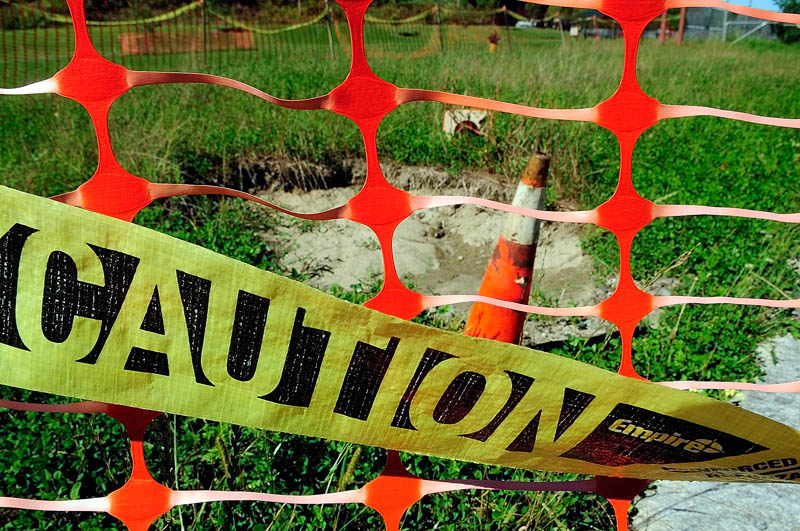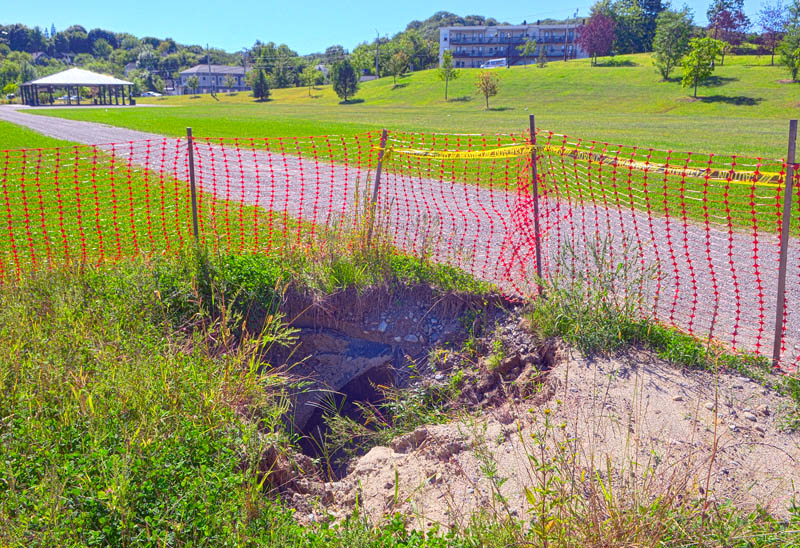AUGUSTA — Two holes in the heart of Mill Park have an appetite for dirt that just can’t be filled.
While the two small sinkholes might not threaten to swallow houses or anything other than more and more dirt, they pose a hazard to park users, not to mention lawn mowers, both of which could fall into the holes.
They’ve grown since they were first discovered earlier this summer, and attempts to fill them with more dirt haven’t worked. The holes just keep returning as the dirt disappears down into them.
So officials are working on a way to fill in the holes — one of which is roughly 8 feet deep — with a remedy they hope will prevent them from returning.
Brian Tarbuck, general manager of the Greater Augusta Utility District, said the sinkholes showed up in the ground above where the district’s contractor placed and buried two nearly 700-foot-long, 10-by-10-foot concrete storage tanks as part of an approximately $15 million project meant to prevent sewage overflows into Bond Brook during heavy rainstorms.
More specifically, the holes are just above where workers had to remove parts of the arched granite block ceilings of two long-buried, long-forgotten aqueducts that apparently carried water from the former mill on the site back to the Kennebec River.
“These buried conduits went perpendicular to the path our concrete boxes needed to take, so we had to punch through these arches. We had no choice but to go through them,” Tarbuck said Friday. “We back-filled it and didn’t think (the filled-in dirt) would go anywhere. If we had, we would have done it differently; but time has told a different tale. We tried to just put more material in it, but that didn’t work.
Left unchecked, the sinkholes could get bigger and cause more problems.”
Tarbuck said the district is working with engineers to find a remedy, which he said may be injecting a “flowable fill” material into the holes that could harden in place and stabilize the ground above the old aqueducts by preventing more fine soils from falling into them.
Tarbuck said he’s not sure how much the fix could cost but said it probably would be in the “tens of thousands” of dollars.
The holes are just south of the park’s petanque courts, between a stone-dust road and the Kennebec River.
One hole is about 8 feet deep, 12 feet wide and 9 feet long. The other is only 2 or 3 feet deep, about 10 feet wide, and 7 feet long.
Both are surrounded by red plastic fencing and yellow “caution” tape to try to keep people away from the holes.
City Councilor Patrick Paradis, chairman of a city committee planning for the park’s future, said a city worker nearly drove a riding lawn-mower into one of the holes before they were properly marked.
“It has to be remedied. It’s getting worse,” Paradis said. “It is the responsibility of the utility district to remedy that.”
Tarbuck agrees.
“I think it’s the district’s responsibility,” he said. “The city let us put these (concrete holding tanks) in the park. It’s no one else’s fault those old structures were dug up. It’s our responsibility to make sure the sinkholes don’t reappear, and keep everyone safe.”
Tarbuck said officials didn’t know the old aqueducts were still underground in the park.
Mill Park was the site of a cotton mill from the 19th century until the Edwards Mill burned in a massive fire in 1989. Some of the mill foundation and other infrastructure remains on the riverside site.
Keith Edwards — 621-5647
kedwards@centralmaine.com
Send questions/comments to the editors.





Success. Please wait for the page to reload. If the page does not reload within 5 seconds, please refresh the page.
Enter your email and password to access comments.
Hi, to comment on stories you must . This profile is in addition to your subscription and website login.
Already have a commenting profile? .
Invalid username/password.
Please check your email to confirm and complete your registration.
Only subscribers are eligible to post comments. Please subscribe or login first for digital access. Here’s why.
Use the form below to reset your password. When you've submitted your account email, we will send an email with a reset code.